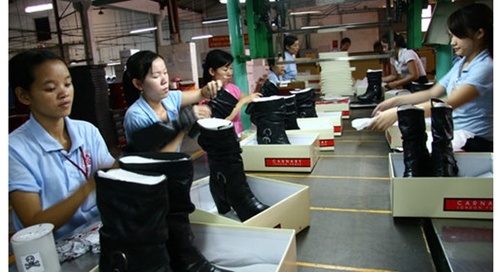 Economy
Economy

The Ministry of Trade and Industry is urging local footwear makers to further invest in support industries instead of depending excessively on imported raw materials and losing out on profits and competitiveness.
 |
| The Ministry of Trade and Industry (MoIT) is urging local footwear makers to further invest in support industries instead of depending excessively on imported raw materials and losing out on profits and competitiveness. — Photo cafebiz.vn |
HÀ NỘI – The Ministry of Trade and Industry (MoIT) is urging local footwear makers to further invest in support industries instead of depending excessively on imported raw materials and losing out on profits and competitiveness.
MoIT’s data shows that the country’s export revenue from leather and footwear products in the first six months of 2016 reached nearly US$6.3 billion, an increase of 8.8 per cent over last year.
This figure is expected to grow once the Free Trade Agreements (FTAs) come into effect, substantiallly reducing or phasing out import taxes. The FTAs, such as the Việt Nam - EU Free Trade Agreement (EVFTA), Trans-Pacific Partnership (TPP), Việt Nam - Korea Free Trade Agreement (KVFTA), are predicted to provide new opportunities for Việt Nam’s leather and footwear companies to develop in both scale and quality. Under the agreements, the current tariff of 17–45 per cent will drop to zero per cent by 2018, helping footwear companies to boost exports.
In 2015, the United States spent nearly $4.1 billion on Việt Nam’s leather and footwear products, up nearly 50 per cent and equal to 33.9 per cent of the sector’s total exports. The US has surpassed the EU to become the largest importer of Vietnamese footwear in the world. The EVFTA is forecast to boost exports by 50 per cent in 2020 and 93 per cent in 2025.
FTAs will help develop the support industry since foreign investors will invest in manufacturing materials to enjoy preferential origin. As a result, Việt Nam can improve the supply of raw materials and increase its localisation ratio.
Phan Thị Thanh Xuân, General Secretary of the Việt Nam Leather, Footwear and Handbag Association (LEFASO) said most key materials for leather shoe production are imported since domestic leather and leatherette supplies meet only 30 per cent of production demands. Many businesses have invested in developing raw material factories, he said, but the leather and footwear companies are still small and lack equipment and product designers.
In addition, increased raw material costs, wages, electricity and water rates pose additional difficulties for the industry, given that Vietnamese footwear makers have to compete with producers from Cambodia and Indonesia.
To deal with these difficulties, the Government should offer preferential tax policies, develop a centralised industrial zone and implement the master plan for the leather and footwear industry adopted by the MoIT, says Nguyễn Đức Thuấn, LEFASO chairman.
Vietnamese enterprises should also invest in new technologies to increase their productivity, said Thuấn. -- VNS




